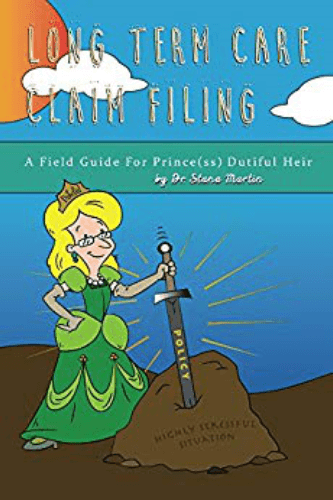So you need to file a claim, eh? Well you have come to the right place…
First, you have to know that this is insurance – it is going to be a document intensive process to get the claim paying. Further, the more care providers and changes in care providers you have had, the more complex this is going to be.
We highly recommend that you purchase the how-to book we have available through AMAZON and on our WEBSITE. Why the book? Well, because if you are going to learn how to do something you have never done before, it is only smart to get a how-to book that will keep your claim out of the denial ditch! But second of all, we have been in the long term care insurance world for over 20 years. Chances are we know a thing or two about how these contracts work and we can steer you in the right direction. If you are not a reader, you can always book a consultation with us at this site: CONSULTATION
If you are a reader, then read on!
STEP ONE: Starting the claim is either done by calling the insurance company or by opening a claim on an online portal. AT the time of this writing, only a few companies have a functional portal, but this is a growing trend and so it is worth it to see if there is a portal that lets you fill out a claim online. Filling out claim paperwork has a number of places where you can make a misstep, however. So, we refer you back to the book or to a consultation to keep from gumming up your claim first rattle out of the box!
STEP TWO: Nurse assessment – the insurance company will send out a nurse to interview the claimant and ask about what care is required. Here is also a pitfall – many seniors will not reveal just how fragile they have become. This is understandable from a human standpoint – after all, when you have lost about everything except your dignity, you will cling to it with every scrap of willpower you have. So someone who is familiar with the care needs should be at this interview to be sure accurate information is being delivered.
STEP THREE: While the nurse assessment is getting booked and done, the claim adjuster at the insurance company will request documents from your care providers. There are some standard things they request across all companies and a few things that are company-specific. The upshot is that the claim adjuster is collecting upwards of 50+ pages of documents from every rehab, skilled nursing facility, assisted living facility, and/or home care company that has provided care. For someone who had rehab, home care, then a new rehab, then assisted living….? That is hundreds and hundreds of pages of records that have to be gathered up and delivered to the claimant’s file in the insurance company’s offices. There are so many ways for this to go wrong, that it is better to ask does it ever go well rather than how can it go wrong! Humans make mistakes (type in wrong fax number, put in wrong policy ID?) and technology can fail us without warning (fax only sends 3 of the 50 pages!). We strongly recommend that people manage/track all the documents that are requested (what document, from whom, what fax or address did it go to, etc.) to be sure no gremlin gets in the works.
STEP FOUR: While the nurse assessment is happening and they are getting medical records from long term care providers, they are also getting medical/clinical notes from attending physicians. The pitfall here is that physicians do not often note in the file that the claimant needs help bathing or dressing or such. They only know to write the diagnosis (Parkinson’s ,f or instance) and something like ‘high fall risk and has had 2 emergency room visits since seen last’. Well those types of notes, while fine for medical care and medical insurance, are woefully inadequate for long term care insurance. They physician must write in the chart that this person needs help with bathing, or dressing, or transferring or any of the other Activities of Daily Living noted in the contract. OR…that they have a severe cognitive impairment that requires supervision. You see, the insurance company is triangulating on the answers from different sources (this is so no one can be in cahoots with someone to defraud the insurance company!). When different sources all attest to the same level of need of care, then the claim is approvable.
STEP 5: Once you have an approval letter (and it is never really until you DO have it in writing!), you still have to make sure that invoices and/or care notes go into the insurance company for all back dates of care and for all future dates of care. This usually means you have to get a staff member at your care giver to agree to take this job on and make sure they have all the policy IDs or claim IDs and mechanisms whereby they can submit documents.
STEP 6: Reconcile the account. The insurance company sends out Explanation of Benefit pages that tell you what was billed and what was paid or denied. Anything that is not paid correctly should be submitted back to the insurance company for re-review until it is correct. Remember, insurance companies hire humans…who make mistakes.
Filing a long term care claim is not impossible. It can be long, tedious and frustrating…but it is also a significant amount of money. We find it is worth it to be detailed and chase things to ground – you can be confident the policy is paying every drop it was supposed to pay for care when you file and manage a claim correctly.
Stana Martin, PhD, founded Mrs LTC to provide a top-quality resource for clients and customers who need help with long term care claims or insurance comparisons.
Questions?
Contact - Mrs. LTC
Long Term Care Claims & Insurance
Question about a Claim?
Shopping for coverage?








